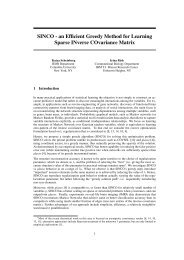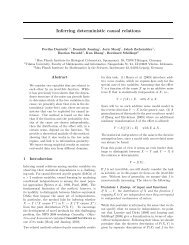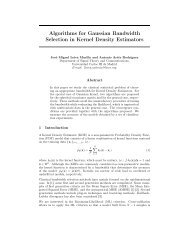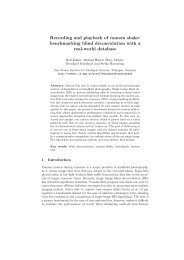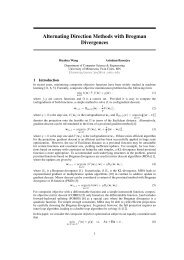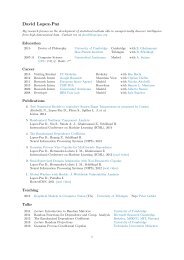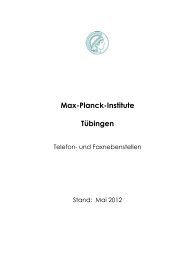Stochastic optimization with non-iid noise - Optimization for Machine ...
Stochastic optimization with non-iid noise - Optimization for Machine ...
Stochastic optimization with non-iid noise - Optimization for Machine ...
Create successful ePaper yourself
Turn your PDF publications into a flip-book with our unique Google optimized e-Paper software.
When data is drawn i.i.d. from an underlying probability distribution, Cesa-Bianchi et al. [3]<br />
have shown that online learning algorithms can indeed output predictors that approximately<br />
minimize the expected function f. Specifically, <strong>for</strong> convex loss functions, the average of the<br />
T predictors played by the online algorithm has <strong>optimization</strong> error (nearly) bounded by<br />
the average regret R T<br />
T<br />
<strong>with</strong> high probability. We ask the same question when the data<br />
ξ t is drawn according to a dependent process. To that end, we show that online learning<br />
algorithms enjoy high-probability convergence guarantees when the samples ξ 1 , ξ 2 , . . . <strong>for</strong>m<br />
a β- or φ-mixing sequence. In particular, we prove that stable online learning algorithms—<br />
those that do not change the predictor x(t) too aggressively between iterations—converge<br />
to the minimum of the population objective f. In favorable regimes of geometric mixing, we<br />
demonstrate convergence rates of O(log T/ √ T ) after T iterations when the loss functions F<br />
are convex and Lipschitz. We also demonstrate faster O(log T/T ) convergence when the loss<br />
function is strongly convex in the hypothesis x, which is often the case <strong>for</strong> regularized problems<br />
such as SVMs, regularized logistic regression, , kernel ridge regression and maximum<br />
entropy estimation. In addition, we consider linear prediction settings, and show O(log T/T )<br />
convergence when a strongly convex loss is applied to a linear predictor 〈x, ·〉, which gives<br />
fast rates <strong>for</strong> problems such as least squares SVMs, linear regression, logistic regression, and<br />
boosting over bounded sets, when samples are not independent and identically distributed.<br />
We build off of a recent paper by Duchi et al. [5], who show high probability bounds on the<br />
convergence of the mirror descent algorithm even in dependent <strong>noise</strong> settings. In particular,<br />
while their results only apply to mirror descent algorithm, here we show a broad family of<br />
algorithms to optimize <strong>with</strong> <strong>non</strong>-i.i.d. data. We also extend their martingale techniques by<br />
exploiting recent ideas of Kakade and Tewari [8], and use a weakened versions of β and φ-<br />
mixing <strong>for</strong> our high probability results. Our proofs use only relatively elementary martingale<br />
convergence arguments, and we do not require that the input data is stationary but only that<br />
it is suitably convergent. More details and proofs can be found in the full-length version [1].<br />
2 Setup, Assumptions and Notation<br />
The online algorithm receives data ξ 1 , . . . , ξ T from the sample space Ξ, where the data is<br />
generated according to a stochastic process P . The algorithm plays points (hypotheses)<br />
x ∈ X , and at iteration t suffers the loss F (x(t); ξ t ). The total variation distance between<br />
distributions P and Q, <strong>with</strong> densities p and q w.r.t. a measure µ, 1 , defined on a space S is<br />
d TV (P, Q) := sup |P (A) − Q(A)| = 1 ∫<br />
|p(s) − q(s)|dµ(s). (4)<br />
A⊂S<br />
2<br />
Define the σ-field F t = σ(ξ 1 , . . . , ξ t ). Let P[s] t denote the distribution of ξ t conditioned on F s ,<br />
that is, given the initial samples ξ 1 , . . . , ξ s . Our main assumption is that there is a stationary<br />
distribution Π to which the distribution of ξ t converges as t grows. We also assume that<br />
the distributions P[s] t and Π are absolutely continuous <strong>with</strong> respect to a fixed underlying<br />
measure µ throughout. We use the following criterion to measure the convergence of P :<br />
Definition 2.1 (Weak β and φ-mixing). The β and φ-mixing coefficients of the sampling<br />
distribution P are defined, respectively, as<br />
{<br />
β(k) := sup 2E[dTV (P t+k (· | F t ), Π)] } {<br />
and φ(k) := sup 2dTV (P t+k }<br />
(· | B), Π) : B ∈ F t .<br />
t∈N<br />
t∈N<br />
The process is φ-mixing (respectively, β-mixing) if φ(k) → 0 as k → ∞, and we assume<br />
<strong>with</strong>out loss that β and φ are <strong>non</strong>-increasing. The above definition is weaker than the<br />
standard definitions of mixing [11, 17], which require mixing over the entire tail σ-field of<br />
the process; we require mixing over only the single-slice marginal of ξ t+k . We also note that<br />
β-mixing is weaker than φ-mixing since β ≤ φ. Two regimes of mixing are of special interest.<br />
A process is called geometrically β-mixing if β(k) ≤ β 0 exp(−β 1 k θ ) <strong>for</strong> some β i , θ > 0, and<br />
similarly <strong>for</strong> φ. <strong>Stochastic</strong> processes satisfying geometric mixing include finite-state ergodic<br />
Markov chains; we refer the reader to the reference [10] <strong>for</strong> more examples. A process is<br />
1 This assumption is <strong>with</strong>out loss, since P and Q are absolutely continuous <strong>with</strong> respect to P +Q.<br />
S<br />
2



